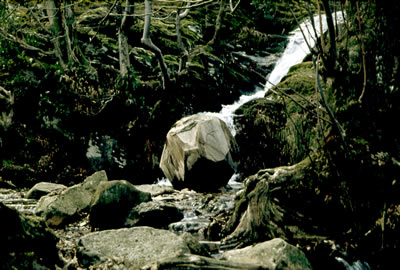
"He (David Nash) first carved a rough sphere... and intended to take this back to his studio. However, access was up a long steep track and at 400 kg and a metre wide, this 'boulder' was dangerous to move downhill. So instead Nash used a nearby stream, where rocky banks would contain the momentum of its descent.
However, a little way down the bank, the boulder became wedged in a waterfall. Nash had no option but to leave it there. It looked good in the streaming water, and so Nash began photographing it... the journey of Wooden Boulder had begun.
The following March heavy rainfall shifted Wooden Boulder into the pool below. Still with the intention of moving it to his studio, Nash hauled it out of the stream and rolled it down the next waterfall to the pool below, where it remained for eight years. It became obvious that the Wooden Boulder belonged to the stream; over the next 24 years it moved nine times during storms, eventually floating into the River Dwyryd estuary. Nash says of Wooden Boulder, 'It is important to the narrative of this "free-range"; sculpture that its material formed and grew on the hill over two centuries. I did not take the wood up the hill. The narrative, like the material, grew organically.'
Text quoted from the Kew Gardens website
Here is a video of Nash talking about Wooden Boulder and another work
